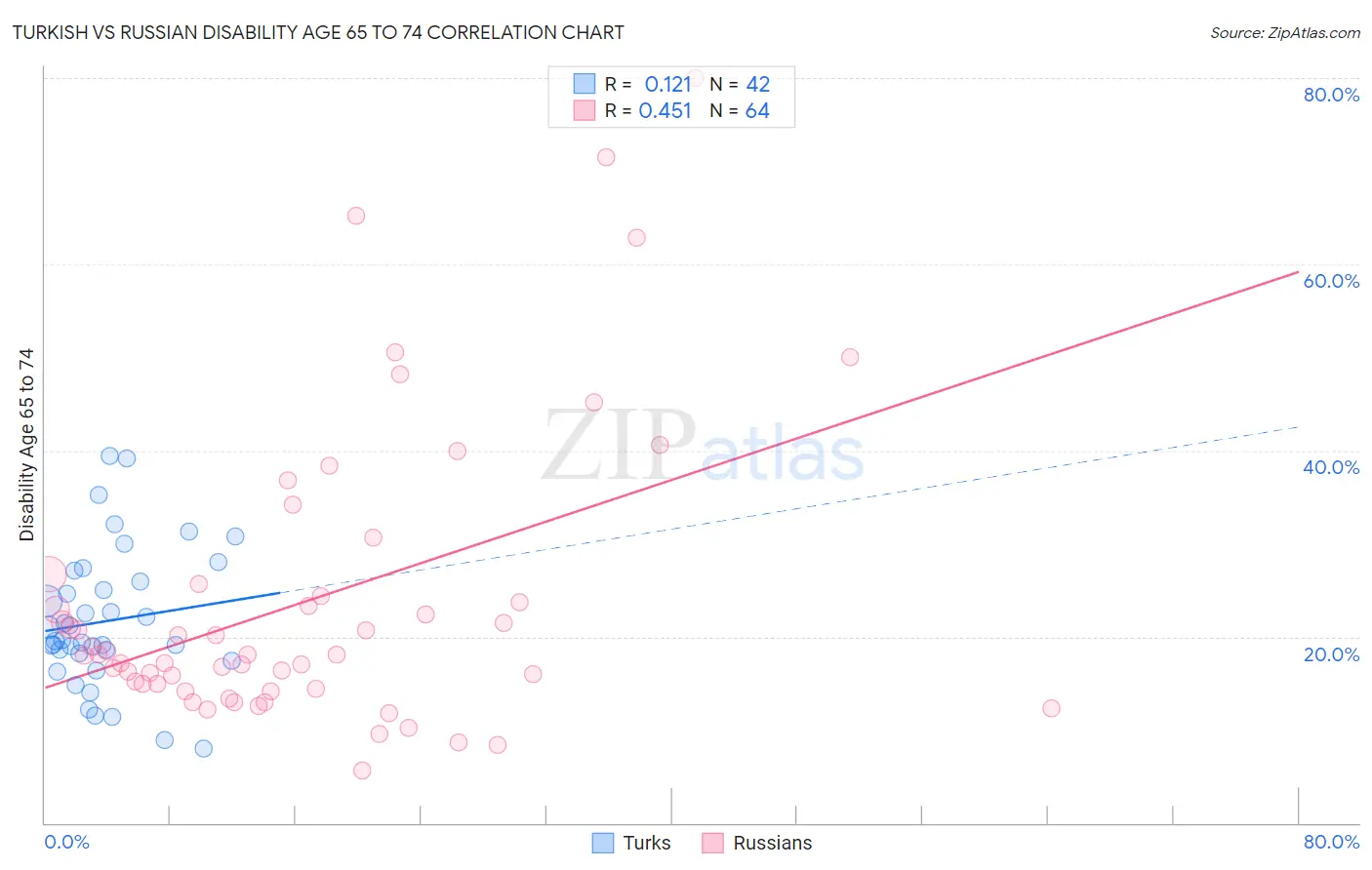Turkish vs Russian Disability Age 65 to 74
COMPARE
Turkish
Russian
Disability Age 65 to 74
Disability Age 65 to 74 Comparison
Turks
Russians
21.0%
DISABILITY AGE 65 TO 74
99.9/ 100
METRIC RATING
32nd/ 347
METRIC RANK
21.2%
DISABILITY AGE 65 TO 74
99.8/ 100
METRIC RATING
38th/ 347
METRIC RANK
Turkish vs Russian Disability Age 65 to 74 Correlation Chart
The statistical analysis conducted on geographies consisting of 271,478,779 people shows a poor positive correlation between the proportion of Turks and percentage of population with a disability between the ages 65 and 75 in the United States with a correlation coefficient (R) of 0.121 and weighted average of 21.0%. Similarly, the statistical analysis conducted on geographies consisting of 510,598,178 people shows a moderate positive correlation between the proportion of Russians and percentage of population with a disability between the ages 65 and 75 in the United States with a correlation coefficient (R) of 0.451 and weighted average of 21.2%, a difference of 0.59%.

Disability Age 65 to 74 Correlation Summary
| Measurement | Turkish | Russian |
| Minimum | 7.9% | 5.7% |
| Maximum | 39.4% | 80.0% |
| Range | 31.5% | 74.3% |
| Mean | 21.7% | 23.9% |
| Median | 19.6% | 18.1% |
| Interquartile 25% (IQ1) | 18.2% | 14.7% |
| Interquartile 75% (IQ3) | 26.0% | 25.0% |
| Interquartile Range (IQR) | 7.8% | 10.4% |
| Standard Deviation (Sample) | 7.4% | 15.8% |
| Standard Deviation (Population) | 7.3% | 15.7% |
Demographics Similar to Turks and Russians by Disability Age 65 to 74
In terms of disability age 65 to 74, the demographic groups most similar to Turks are Immigrants from Northern Europe (21.0%, a difference of 0.030%), Immigrants from Greece (21.0%, a difference of 0.070%), Immigrants from Japan (21.0%, a difference of 0.11%), Immigrants from Czechoslovakia (21.0%, a difference of 0.15%), and Immigrants from Argentina (21.1%, a difference of 0.20%). Similarly, the demographic groups most similar to Russians are Israeli (21.2%, a difference of 0.0%), Immigrants from Switzerland (21.1%, a difference of 0.11%), Argentinean (21.2%, a difference of 0.18%), Bulgarian (21.1%, a difference of 0.30%), and Latvian (21.2%, a difference of 0.35%).
| Demographics | Rating | Rank | Disability Age 65 to 74 |
| Bolivians | 99.9 /100 | #25 | Exceptional 21.0% |
| Immigrants | Australia | 99.9 /100 | #26 | Exceptional 21.0% |
| Immigrants | Sweden | 99.9 /100 | #27 | Exceptional 21.0% |
| Immigrants | Czechoslovakia | 99.9 /100 | #28 | Exceptional 21.0% |
| Immigrants | Japan | 99.9 /100 | #29 | Exceptional 21.0% |
| Immigrants | Greece | 99.9 /100 | #30 | Exceptional 21.0% |
| Immigrants | Northern Europe | 99.9 /100 | #31 | Exceptional 21.0% |
| Turks | 99.9 /100 | #32 | Exceptional 21.0% |
| Immigrants | Argentina | 99.9 /100 | #33 | Exceptional 21.1% |
| Immigrants | Sri Lanka | 99.9 /100 | #34 | Exceptional 21.1% |
| Bulgarians | 99.9 /100 | #35 | Exceptional 21.1% |
| Immigrants | Switzerland | 99.8 /100 | #36 | Exceptional 21.1% |
| Israelis | 99.8 /100 | #37 | Exceptional 21.2% |
| Russians | 99.8 /100 | #38 | Exceptional 21.2% |
| Argentineans | 99.8 /100 | #39 | Exceptional 21.2% |
| Latvians | 99.8 /100 | #40 | Exceptional 21.2% |
| Immigrants | Austria | 99.8 /100 | #41 | Exceptional 21.2% |
| Macedonians | 99.7 /100 | #42 | Exceptional 21.3% |
| Immigrants | Croatia | 99.7 /100 | #43 | Exceptional 21.3% |
| Estonians | 99.7 /100 | #44 | Exceptional 21.4% |
| Asians | 99.7 /100 | #45 | Exceptional 21.4% |